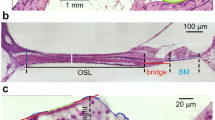Summary
The maturation of the endocochlear potential (EP) and the inner ear fluid ionic composition were studied in fetal and neonate guinea pigs. The concentration of sodium and potassium in endolymph and perilymph approximated adult values more than 2 weeks before birth. Endolymph had acquired its specific ionic composition before the onset of cochlear microphonics (52–55 gestation days, results of other authors). Positive EP was recorded starting on day 62 of gestation. The EP rose fast to reach near adult level at birth. It is speculated that the negative EP recorded after the onset of cochlear microphonics was an artifact, probably a result of fetal hypoxia. The significance of the negative EP recorded before the onset of the cochlear microphonics is discussed in relation to the source of the anoxic negative EP in the adult animal.
Similar content being viewed by others
References
Anggard L (1965) An electrophysiological study on the cochlear function in the rabbit. Acta Otolaryngol [Suppl] (Stockh) 203: 1–64
Anniko M, Wroblewski R (1981) Elemental composition of the developing inner ear. Ann Otol Rhinol Laryngol 90: 25–32
Bosher SK (1979) The nature of the negative endocochlear potentials produced by anoxia and ethacrinic acid in the rat and guinea pig. J Physiol 293: 329–345
Bosher SK, Warren RL (1971) Study of the electrochemistry and osmotic relationship of the cochlear fluids in the neonatal rat at the time of development of the endocochlear potential. J Physiol 212: 739–761
Konishi T (1979) Some observations on negative endocochlear potential during anoxia. Acta Otolaryngol (Stockh) 87: 506–516
Marcus DC, Demott JE, Kobayashi T, Ge X-X, Thalman R (1981) Specificity of action of vandate to the organ of corti. Hear Res 5: 231–243
Pujol R, Hilding DA (1973) Anatomy and physiology of the onset of auditory function. Acta Otolaryngol (Stockh) 76: 1–10
Pujol R, Carlier E, Lenoir M (1980) Ontogenic approach to inner and outer hair cell functions. Hear Res 2: 423–430
Romand R (1971) Maturation des potentiels cochleaires dans la periode perinatale chez le chat et chez le cobaye. J Physiol (Paris) 63: 763–782
Sitko ST, Steriloff D, Honrubia V (1976) Source and maintenance of the endocochlear potential. Otol Rhinol Laryngol 82: 328–335
Tasaki I, Spyropoulos CS (1959) Stria vascularis as source of EP. J Neurophysiol 22: 149–155
Thorn L (1975) Die Entwicklung des Cortischen Organs beim Meerschweinchen. Adv Anat Embryol Cell Biol 51 (6): 1–97
Author information
Authors and Affiliations
Rights and permissions
About this article
Cite this article
Raphael, Y., Ohmura, M., Kanoh, N. et al. Prenatal maturation of endocochlear potential and electrolyte composition of inner ear fluids in guinea pigs. Arch Otorhinolaryngol 237, 147–152 (1983). https://doi.org/10.1007/BF00463614
Received:
Accepted:
Issue Date:
DOI: https://doi.org/10.1007/BF00463614




